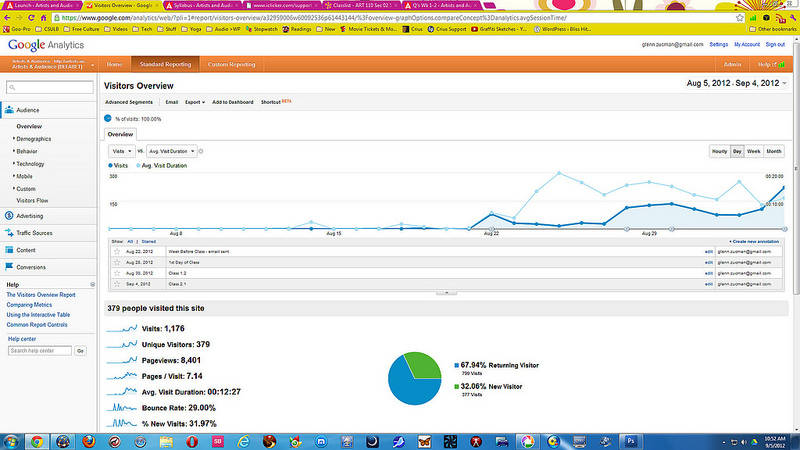Written by Fernando Maciá
Índice
- 1. Define what are the objectives of our website in business terms.
- 2. Identify which measures will be used to measure the evolution of these objectives.
- 3. Designing a Balanced Scorecard Template
- 4. Schedule periodic Balanced Scorecard consultation to detect what is working and what can be improved.
- 5. Make decisions on actions to improve the site’s performance.
Measuring the performance of a website, its
Return on Investment
is a factor that companies are increasingly taking into account given the growing investment in design, programming, content generation, promotion, etc. that being on line requires nowadays. Until recently, the simple presence of the company on the Internet through a static website whose contents were hardly updated was considered sufficient. However, Internet users today demand websites that meet usability criteria, with attractive designs, with multiple functionalities, with constantly updated content, programmed using compatible code and optimized both for fast downloading and for being properly indexed by search engines. Meeting these multiple requirements requires a level of investment that mere Internet presence no longer justifies:
It is necessary to set objectives to be met by the website, measure the degree to which it achieves them, know where and how to apply corrective measures and be able to know what ROI we are obtaining.
The
web analytics
is the first and most important source of information when it comes to measuring the performance of our website. However, they have a number of drawbacksThe following is an example: a large number of measures are presented indiscriminately – bandwidth consumed, unique visitors, pages viewed, usual navigation routes, errors – without differentiating the relevance of each of them; many of these measures require familiarity with technical concepts that are only within the reach of systems personnel; their use is often complex, and finding the correlation between different measures requires in-depth technical knowledge of the application; this complexity means that they are consulted infrequently, which prevents trends or inflections from being detected.
In short, traffic statistics generate a large volume of information but are of little use to a manager.
To translate all this volume of data into relevant information that allows us to know what is working and what is not working on our website and, above all, why it is working. we need to select only a small number of measures and the relationships between them to form what we call the Balanced Scorecard of a web site. This Balanced Scorecard draws specifically on those aspects that are relevant to the tactical and strategic decisions of the business, which we call Key Performance Indicators. They do not present technical data, but rather show the evolution of a certain business aspect. It is not necessary to have a technical background, but only a marketing background, to understand the measured indicator and its trend.
In contrast to traffic statistics, the Balanced Scorecard provides very specific in-depth information that is understandable to any business manager.
By the way, you may be surprised that at this point in the article I still haven’t talked about web traffic. As you will see below, a large volume of visitors is only a relevant measure for a certain type of site. On the other hand, we are going to concentrate more on the concept of Customer Conversion Rate, defined as the percentage of the total number of visitors to your site that reach the goal you have set for your website.
Let’s see now how we can, in five steps, design our own Balanced Scorecard for our website:
1. Define what are the objectives of our website in business terms.
To begin with, a question: is our website aligned with our company’s marketing mix? In other words, do you have a goal to achieve?
If my website is an e-commerce, my goal is sales. If my website is a real estate portal, my goal is to attract prospects. If my website is a corporate portal, my objectives may have to do with concepts such as branding, customer service, after-sales support, attracting franchisees… If my website is institutional, then I have informative, public relations and general positioning objectives. If my website is a media company, I will have objectives based on the number of visitors, page views, registered users, etc. that affect my advertising or subscription income.
Whatever they are, I will first have to define what success means for my website, when I can consider that my website is meeting objectives that justify the investment of resources in it.
2. Identify which measures will be used to measure the evolution of these objectives.
From the objectives defined in point 1, I will select
in my web traffic statistics application only those measures related to the objectives I want to know. To continue with the previous examples and, in a very generic way:
- If my website is an e-commerce, I will look at, among others:
- Total number of unique visitors
- Number of products added to shopping cart
- Number of purchases satisfactorily completed
- Number of purchases not concluded
- Most viewed product categories
- Most viewed product sheets
- Best-selling product categories
- Best selling products
- Origin of visits
- To offer an antagonistic example, if my website is an institutional portal, I will look at, among others:
- Total number of unique visitors
- Number of repeat visitors
- Number of subscribers to my newsletter
- Number of users registered on the site
- Number of users responding to an online survey
- Average time spent in the site per visit
- Average page views per visit
- Number of information request forms sent
- Number of FAQ or similar page views
- Origin of visits
- Most viewed pages/sections
- Least viewed pages/sections
3. Designing a Balanced Scorecard Template
The Scorecard integrates these measures and translates them into business terms, i.e. Key Performance Indicators.
- Regarding e-commerce, I would like to know, among others:
- Total visitors: the data is derived from the total number of unique visitors.
- Total confirmed orders: the figure is derived from the number of successfully completed purchases.
- Conversion rate to customer: percentage that represents the total number of confirmed orders with respect to the total number of visitors to the website. The higher the better.
- Obstacles to purchase: the data is derived from the number of purchases not completed. It allows me to detect programming or usability problems.
- Most demanded products: the data comes from the most viewed categories and product sheets.
- Most purchased products: the data comes from the most purchased product files.
- Latent demand: if there are discrepancies between the most consulted products and the most sold ones, it may be because my product offer is not attractive in the most demanded categories, or my prices are not competitive…
- Origin of the visits: I will distinguish between those coming from search engines, Pay Per Click campaigns, banners or direct visits. Based on this I can plan the return on investment in the different types of site promotion.
- Regarding the institutional portal, you might want to know:
- Total visitors: the data is derived from the total number of unique visitors.
- Conversion rate to customer: I could qualify a visit as successful based on the number of visitors who sign up or subscribe to my newsletter. In this case, you could add the two figures together and find what percentage they represent of the total number of visits to the site.
- Depending on the objectives of the website, another measure of the quality of a visit could be a minimum time spent on the site or a minimum number of pages viewed in a session, or also a certain number of repeat visits to the site… In each case, I would use the corresponding figure to find the conversion rate to customer with respect to the total number of visits to the site.
- Most viewed sections: these indicate sections that attract the highest level of traffic. Perhaps you could increase the permanence on the site or the number of page views by placing links to other related content on these pages.
- Least viewed sections: indicate to me sections that generate less interest. I may decide that in the future it is worthwhile to invest fewer resources in developing new content for these sections or to analyze whether they present usability, design or focus problems.
4. Schedule periodic Balanced Scorecard consultation to detect what is working and what can be improved.
The Balanced Scorecard is used to filter, from the total information provided by the traffic statistics system, only the most representative data according to their relationship with the objectives set. Periodic monitoring of these few data allows me to detect their evolution over time.
The Balanced Scorecard can also be specialized so that each department finds in it only data related to its own activity.
5. Make decisions on actions to improve the site’s performance.
From the periodic consultation of the data, we are in a position to initiate actions to continuously improve the performance of our site. Examples:
- A customer service department would, for example, be interested in knowing what number of visitors came to the FAQ page and what percentage of them filled out a form requesting additional information. Obviously, a lower percentage will be an indication of a higher satisfaction rate of the FAQ section.
- A department for the acquisition of second-hand properties for sale would be interested in knowing the evolution of the inquiries for each area. This evolution will indicate a greater interest by the demand in some areas while others will show a decreasing interest, so that they can concentrate on increasing the acquisition of properties in the areas where demand is growing.
- A marketing department may decide to stop investing in pay-per-click ads if it finds that the conversion rate of the visits coming from them is very low and increase its investment in organic search engine optimization if it has a higher conversion rate to customer.
- In short, we would be able to test any change (vary the navigation, introduce an internal search engine, add a section of related products on each content page, change the design or layout of the shopping cart) and see how it affects the behavior of those few measures that we have defined as critical to the performance of our site.
To recapitulate: We have defined certain objectives that the site should meet; we have established how we are going to measure those objectives; we have selected those data, from among the multiple measures of the statistical traffic analysis system, that serve us to measure the evolution of those objectives. We have translated these data and the relevant relationships between them into business terms, perfectly understandable for management, and put them together in a Balanced Scorecard. And we have programmed a periodic consultation of the data by the heads of each department that will allow us to monitor their evolution, detect opportunities for improvement and adopt decisions aimed at improving the degree of achievement of the objectives set.
In this way, we can focus investments only on those areas that need or deserve them. All this allows us to focus on what really determines the ROI of our website: the conversion rate to customer. It means moving from a quantitative concept (“I have a website with a lot of traffic”) already obsolete to a qualitative concept (“I have a website with high performance”) that will determine the success of future websites.


